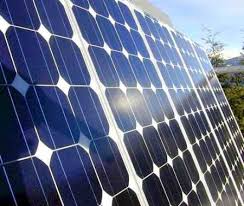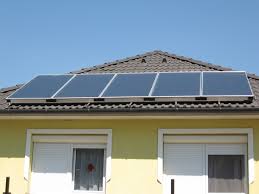Mar 29 2010
With the onset of an early and hot summer and news reports about likely low electricity generation in the months ahead from the hydro power corporations due to fall in water level in the dams, the thought of a hot afternoon with power cuts has started haunting the senses. The possibility of storing energy from the sun to power homes seems such an easy solution but has proved wishful thinking all these years. The discomfort of heat and power cuts, with the abundance of the sun for most part of the year may have led the country to set an ambitious target of 22,000 mw of solar power by 2022. It may be interesting to look at the economics of solar power in India.
Solar energy has great potential as a renewable resource in India. It has the capacity to meet the lighting and other energy needs of India’s 72 million poor households that have no access to electricity. Solar energy typically has four distinct categories of uses – it may be grid connected and generated from large photovoltaic (PV) and solar thermal power plants, and smaller rooftop systems. Solar power may be distributed off grid too. Solar collectors for low temperature applications and solar lighting system for rural areas are the other two categories.

India has launched the National Solar Mission (NSM), which is one of the eight missions of the National Action Plan on Climate Change (NAPCC). The NSM has set targets for each of the above category of uses. By 2022 the target of grid-connected electricity is 20,000 mw and off grid electricity is 2,000 mw. The target for solar collectors is 20 million square meters, which is revised downward from 30,000 million square meters, and the target for solar lighting system is 20 million. The existing capacity for grid connected solar energy is 6 mw and off grid is 2.4 mw; there are 3 million square metre of solar collectors and 1.3 million solar lighting systems. These initial installed capacities give an indication of the magnitude of challenge the NSM would face in the coming years to achieve targets.
The economics of solar power depends largely on the cost and finding the appropriate tariff. Due to the differences in various solar thermal and PV technologies in India, it is difficult to predict their cost and subsequently define an appropriate feed-in tariff. A low feed-in tariff might not be attractive for the industry to respond, and high feed-in tariff would attract too many but result in a very high dose of subsidy dole out. The correct price discovery is crucial for the growth of solar energy use.

There are usually two approaches for price discovery in solar energy plants. In one approach, all power may be bought at a fixed tariff and there is no bar on capacity. The second is quantity-based, where a quota ceiling is fixed and met through competitive bidding. The response of bidders to some pilot projects by the ministry of non-renewable energy and state governments has been encouraging. The MNRE set the tariff rates at Rs 13 and Rs 15 per kWh for solar thermal and PV, respectively. The state governments offered even lower tariffs. The project proposals received were far more than the capacity targets. This indicates that the tariff rates have been acceptable to the solar power developers. Experiences in other countries suggest that selection process has to be transparent and objective. Without this, the NSM runs the risk of delays due to corruption.
The mechanism of feed-in tariff without a capacity ceiling has been successful in countries like Germany where they had a strict digression rate. The digression rate was determined by year-on-year tariff reduction based on capacity creation and project costs. In India, there is lack of reliable data on project costs. Therefore, it is difficult to operate this method. On the other hand, in bidding process the lowest possible tariff would be discovered, which would ensure lower cost to consumers and avoid controversies and delays in project execution. A precondition for technical capabilities and financial soundness, as followed in the US, would ensure that only serious bids are observed.
However, there is a problem with the price discovery process described above. It may be noted that there are several technologies that are in the initial stage of development and have the potential for indigenous manufacturing and long run price reduction. Such technologies will be excluded in a purely price-based competitive bidding. Hence, a technology-based competitive bidding could be adopted to encourage multiple solar thermal technologies.
The point of interest and optimism about solar power generation is that the cost has decreased appreciably in the past few years. Photovoltaic costs may fall significantly in the coming years due to international demand and technology improvements.
The cost of generation for solar thermal is even lower than PV. Solar thermal plants have several advantages; the option of thermal storage can generate electricity during peak hours, thus providing an effective solution for base load and dispatchable power. Indian engineering and manufacturing firms can use their expertise in cost optimisation from their experience in steam-based and other conventional method of power generation. There is plenty of scope to reduce cost to make the option of solar power economically viable. A public process should be immediately set in to quickly develop a comprehensive plan for implementation of solar home lighting systems and off grid solutions - these would imply complete liberation from power cuts.
(The writer is a senior
economist at National
Institute of Public Finance and Policy, Delhi)
Solar energy has great potential as a renewable resource in India. It has the capacity to meet the lighting and other energy needs of India’s 72 million poor households that have no access to electricity. Solar energy typically has four distinct categories of uses – it may be grid connected and generated from large photovoltaic (PV) and solar thermal power plants, and smaller rooftop systems. Solar power may be distributed off grid too. Solar collectors for low temperature applications and solar lighting system for rural areas are the other two categories.

India has launched the National Solar Mission (NSM), which is one of the eight missions of the National Action Plan on Climate Change (NAPCC). The NSM has set targets for each of the above category of uses. By 2022 the target of grid-connected electricity is 20,000 mw and off grid electricity is 2,000 mw. The target for solar collectors is 20 million square meters, which is revised downward from 30,000 million square meters, and the target for solar lighting system is 20 million. The existing capacity for grid connected solar energy is 6 mw and off grid is 2.4 mw; there are 3 million square metre of solar collectors and 1.3 million solar lighting systems. These initial installed capacities give an indication of the magnitude of challenge the NSM would face in the coming years to achieve targets.
The economics of solar power depends largely on the cost and finding the appropriate tariff. Due to the differences in various solar thermal and PV technologies in India, it is difficult to predict their cost and subsequently define an appropriate feed-in tariff. A low feed-in tariff might not be attractive for the industry to respond, and high feed-in tariff would attract too many but result in a very high dose of subsidy dole out. The correct price discovery is crucial for the growth of solar energy use.

There are usually two approaches for price discovery in solar energy plants. In one approach, all power may be bought at a fixed tariff and there is no bar on capacity. The second is quantity-based, where a quota ceiling is fixed and met through competitive bidding. The response of bidders to some pilot projects by the ministry of non-renewable energy and state governments has been encouraging. The MNRE set the tariff rates at Rs 13 and Rs 15 per kWh for solar thermal and PV, respectively. The state governments offered even lower tariffs. The project proposals received were far more than the capacity targets. This indicates that the tariff rates have been acceptable to the solar power developers. Experiences in other countries suggest that selection process has to be transparent and objective. Without this, the NSM runs the risk of delays due to corruption.
The mechanism of feed-in tariff without a capacity ceiling has been successful in countries like Germany where they had a strict digression rate. The digression rate was determined by year-on-year tariff reduction based on capacity creation and project costs. In India, there is lack of reliable data on project costs. Therefore, it is difficult to operate this method. On the other hand, in bidding process the lowest possible tariff would be discovered, which would ensure lower cost to consumers and avoid controversies and delays in project execution. A precondition for technical capabilities and financial soundness, as followed in the US, would ensure that only serious bids are observed.
However, there is a problem with the price discovery process described above. It may be noted that there are several technologies that are in the initial stage of development and have the potential for indigenous manufacturing and long run price reduction. Such technologies will be excluded in a purely price-based competitive bidding. Hence, a technology-based competitive bidding could be adopted to encourage multiple solar thermal technologies.
The point of interest and optimism about solar power generation is that the cost has decreased appreciably in the past few years. Photovoltaic costs may fall significantly in the coming years due to international demand and technology improvements.
The cost of generation for solar thermal is even lower than PV. Solar thermal plants have several advantages; the option of thermal storage can generate electricity during peak hours, thus providing an effective solution for base load and dispatchable power. Indian engineering and manufacturing firms can use their expertise in cost optimisation from their experience in steam-based and other conventional method of power generation. There is plenty of scope to reduce cost to make the option of solar power economically viable. A public process should be immediately set in to quickly develop a comprehensive plan for implementation of solar home lighting systems and off grid solutions - these would imply complete liberation from power cuts.
(The writer is a senior
economist at National
Institute of Public Finance and Policy, Delhi)

No comments:
Post a Comment